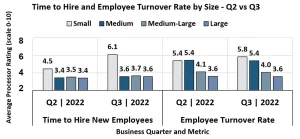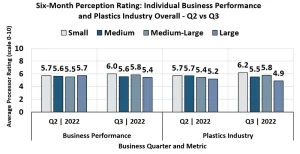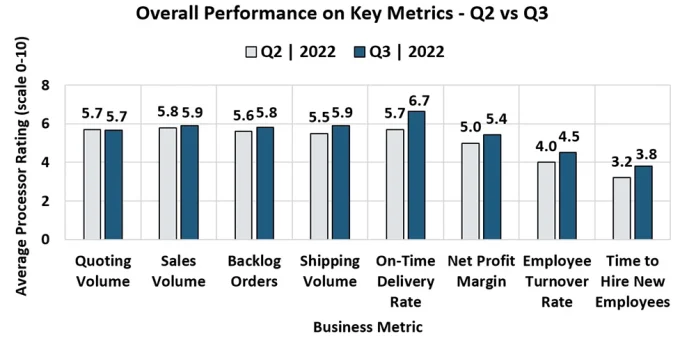by Andrew Carlsgaard, business relations manager, MAPP
With recession and inflation concerns looming, plastics manufacturing leaders maintain a lukewarm stance on key industry metrics at the end of Q3, and only 13% have a positive six-month outlook on the industry overall.
 Over the past two and a half years, dynamic conditions in the plastics industry, manufacturing and global economy have increased the need for constant operational reassessment from a managerial perspective. MAPP has been fortunate to have forward-thinking and curious members, allowing for frequent pulse checks of the status of its operations to stack up against industry peers every quarter. Overall, the 150 participating member organizations in Q3 saw improvement in the supply chain status from Q2 (in line with recent global trends), although organizations maintained a conservative stance towards the potential of increased sales volume and profits with labor issues persisting and demand slowing in many segments.
Over the past two and a half years, dynamic conditions in the plastics industry, manufacturing and global economy have increased the need for constant operational reassessment from a managerial perspective. MAPP has been fortunate to have forward-thinking and curious members, allowing for frequent pulse checks of the status of its operations to stack up against industry peers every quarter. Overall, the 150 participating member organizations in Q3 saw improvement in the supply chain status from Q2 (in line with recent global trends), although organizations maintained a conservative stance towards the potential of increased sales volume and profits with labor issues persisting and demand slowing in many segments.
 The survey’s respondents for Q3 represent plastics processing organizations covering over 20 different industries, with the majority (over 64%) tailoring to the medical, automotive, industrial and consumer goods segments. For this analysis, the respondent organizations were stratified into four general sizes: Small (<$5M annual revenue), medium ($5M-$14.9M), medium-large ($15M-$49.9M) and large ($50M+). Three-quarters of the respondents belong to “medium” to “medium-large”-sized organizations.
The survey’s respondents for Q3 represent plastics processing organizations covering over 20 different industries, with the majority (over 64%) tailoring to the medical, automotive, industrial and consumer goods segments. For this analysis, the respondent organizations were stratified into four general sizes: Small (<$5M annual revenue), medium ($5M-$14.9M), medium-large ($15M-$49.9M) and large ($50M+). Three-quarters of the respondents belong to “medium” to “medium-large”-sized organizations.
Overall, the survey results heavily indicate significant agreement on most critical issues across the board from organizations of all sizes, in line with the previous quarter’s findings. Executives concur that there will be headwinds in the supply chain in the short term and that optimism in key metrics should be tempered. The perceived outlook for nearly all metrics (sales volume, profit margin, hiring, etc.) as of the end of Q3 all rated six or less on average on a scale of one to ten (ten being most optimistic), except for on-time delivery rate. This signals executives’ confidence in delivering on orders, and since the supply chain impacts delivery performance so profoundly, any improvement there is bound to give leaders optimism.
On the other hand, two metrics that rated on average less than five or “acceptable” were hiring of new employees and employee turnover, which aligns with the current challenging environment in hiring and employee movement across all industries – particularly for large-scale operations. Additionally, perceptions of the plastics industry’s overall performance and each business’s outlook for the next six months averaged nearly identically between five and six, signaling that most executives likely believe success depends on the industry’s strength.
As with the hiring issues, the supply chain issues that have persisted since the onset of Covid-19 in early 2020 still appear top-of-mind despite gradual improvements overall in the worldwide market. While in Q2, every respondent experienced at least minimal issues, and nearly 50% experienced moderate issues, the Q3 respondents reported having seen improvements to their supply chain, with the majority (59%) only seeing “no” or “minimal” issues.
Still, obtaining raw materials was the most prevalent supply chain hurdle, with 63% of organizations responding having experienced this problem to some degree in Q3 (down from 84% in Q2). Interestingly, despite the increased costs to manufacturers due to supply chain challenges, raw materials prices and inflation, organizations across the board reported moderate success in passing on costs to customers, helping to at least maintain current margins.
Lastly, there were many helpful comments and observations in the open-ended response section that, while being a smaller sample size (less than a third of respondents), should be worth further consideration. Most of the commenting organizations mentioned there is still an issue with the labor market, and the pipeline for talent is not where it needs to be to alleviate current shortages.
One mid-sized member said, “Turnover is the highest it has ever been in the history of the company.” Another claimed, “We could ship 20% more if we could find the people.”
Also, many organizations noted an improvement in the supply chain, reinforcing the data from all 150 organizations. Still, simultaneously organizations also are seeing decreased orders from customers, with overstock inventory tending to be a primary reason for the reduced demand. As one leader explained: “We are coming off a couple of years of extreme demand and now it appears customers have over-ordered…so sales volumes are down as customers work through the glut of inventory.”
Some also pointed to the political and economic forces to explain their current situations, citing inflation, the housing market and the 2022 midterm elections as forces that will determine success in Q4 and beyond. All these issues will be worth tracking over the next quarter to determine the industry’s strength going into a (hopefully) less turbulent and more prosperous 2023.
More information: www.mappinc.com/resources/benchmarking





